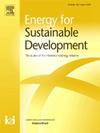微型电网实施的决策模型:超越清洁能源获取的新兴角色——来自印度的具有全球相关性的证据
IF 4.9
2区 工程技术
Q2 ENERGY & FUELS
引用次数: 0
摘要
在社会经济差异和地理限制突出的地区,获得可靠和可持续的电力仍然是一项重大挑战,加剧了能源获取的不平等。微型电网和微电网作为一种有前景的可再生能源解决方案出现,在促进经济发展的同时弥合了清洁能源获取方面的差距。然而,实施千年发展目标面临着与法规、融资和社会经济因素相关的重大挑战。本研究考察了印度MGs的发展,重点关注不断发展的监管框架、社会经济条件和地理空间因素如何影响部署决策。所开发的分析框架提供了适用于其他资源受限和地理挑战性背景下的电力接入规划的见解,从而扩展了该研究的全球相关性。对七个州实施的942个公共mg进行了地理空间分析,考察了人口密度、与现有电网的接近程度、土地利用、灌溉模式和可达性等变量。从贾坎德邦610个以前没有通电的村庄进一步获得了详细的见解,分析了基于社会经济和地理空间参数的部署决策。开发了决策树分类模型来检查电气化策略的选择,包括mg,独立太阳能系统或延迟电气化。研究结果强调,MGs尤其被部署在具有挑战性的地形,如洪水易发地区、森林和高海拔地区,在这些地区,电网扩展在技术和商业上可能是不切实际的。人口稀少的地区需要定制的MG解决方案,而道路连通性差且距离电网较远的村庄则具有更高的MG采用率。本研究为MG的部署和监管改革提供了基于证据的建议,以确保非歧视,并通过竞争性招标实施USO基金授予VGF。本文章由计算机程序翻译,如有差异,请以英文原文为准。

Decision models for minigrid implementation: Emerging role beyond clean energy access - evidence from India with global relevance
Access to reliable and sustainable electricity remains a critical challenge in regions marked by socio-economic disparities and geographic constraints, exacerbating energy access inequities. Minigrids and microgrids (MGs) emerge as a promising renewable energy solution, bridging the gap in clean energy access while fostering economic development. However, implementing MGs faces significant challenges related to regulations, financing, and socio-economic factors.
This study examines the development of MGs in India, focusing on how evolving regulatory frameworks, socio-economic conditions, and geo-spatial factors influence deployment decisions. The analytical framework developed offers insights adaptable to electricity access planning in other resource-constrained and geographically challenging contexts, thereby extending the research's global relevance. A geo-spatial analysis of 942 public MGs implemented across seven states was conducted, examining variables such as population density, proximity to existing grids, land use, irrigation patterns, and accessibility. Detailed insights were further derived from 610 previously unelectrified villages in Jharkhand, analysing deployment decisions based on socio-economic and geo-spatial parameters. A decision-tree classification model was developed to examine the selection of electrification strategies, including MGs, stand-alone solar systems, or deferred electrification. The findings highlight that MGs have been particularly deployed in challenging terrains, such as flood-prone, forested, and high-altitude areas, where grid extension may be techno-commercially impractical. Sparse population regions necessitate customized MG solutions, while villages with poor road connectivity and greater distances from electricity networks exhibit higher adoption rates of MGs. This study offers evidence-based recommendations for MG deployment and regulatory reforms ensuring non-discrimination and operationalize a USO fund awarding VGF via competitive bidding.
求助全文
通过发布文献求助,成功后即可免费获取论文全文。
去求助
来源期刊

Energy for Sustainable Development
ENERGY & FUELS-ENERGY & FUELS
CiteScore
8.10
自引率
9.10%
发文量
187
审稿时长
6-12 weeks
期刊介绍:
Published on behalf of the International Energy Initiative, Energy for Sustainable Development is the journal for decision makers, managers, consultants, policy makers, planners and researchers in both government and non-government organizations. It publishes original research and reviews about energy in developing countries, sustainable development, energy resources, technologies, policies and interactions.
 求助内容:
求助内容: 应助结果提醒方式:
应助结果提醒方式:


